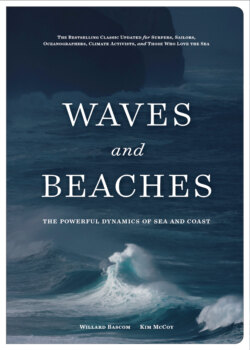Читать книгу Waves and Beaches - Kim McCoy - Страница 27
На сайте Литреса книга снята с продажи.
MASS TRANSPORT
ОглавлениеThis difference in wave position is the result of what is called mass transport. Until now we had supposed that the water returned to its original position after each wave passed, but then we found that when waves are steep, the orbital circles of the water particles do not exactly close. The water itself is transported by the passing waveform, although its progress is very slow compared to the wave velocity. The volume of water so moved is negligible for waves of small steepness (the usual circumstances) and can be disregarded for all practical purposes.
However, the existence of this mass transport is a serious matter to theoreticians. The early workers, including Gerstner and W. J. M. Rankine, concerned themselves only with rotational flow, in which each particle completed a perfect circle as the waveform passed. Later, George Airy and C. C. Stokes developed the irrotational theory, which requires that the water move forward slightly as the waveform passes. This irrotational flow of water due to wave action is now called Stokes drift and is in the direction of wave propagation.
This actual motion of the water is proportional to the square of the height of the waves, and is much more pronounced at the surface than a short distance down. In a wave channel, there is an imperceptibly small return flow of water along the bottom in the opposite direction to compensate for the surface transport by the waves.
One final experiment remains to be performed. We must now examine what happens to the water particles as the wave is transformed into a breaker by the sloping beach at the end of the tank (see figure 11, page 62). The breaking motion is too rapid to be followed. Moreover, each breaker tends to disintegrate and cast the particles up on the beach. A more sophisticated method of recording the wave motion is now possible by using multiple fast frame-rate synchronized cameras, feature-recognition software (similar to facial recognition), and proper lighting.
FIGURE 11: Movement of water particles as a wave transforms into a breaker in shallow water. Bottom friction causes the upper part of the wave to shear forward with all of its remaining energy.
